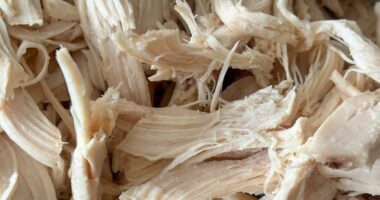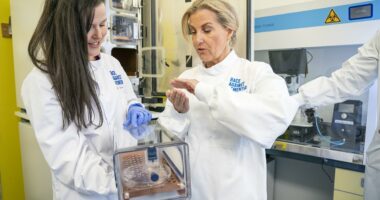Share this @internewscast.com
Scientists have uncovered a new group of rogue proteins in the brain that could play a major role in triggering and worsening Alzheimer’s disease.
Until now, researchers believed that clumps of amyloid and tau proteins were the main culprits behind the devastating cognitive decline seen in Alzheimer’s patients.
But a new study from Johns Hopkins University has identified more than 200 other misfolded proteins in rats that may also be damaging brain function and accelerating memory loss.
A misfolded protein is a one that has not taken on its correct three-dimensional shape.
The researchers say these hidden proteins don’t form large clumps like amyloids, making them harder to detect. They suspect these improperly shaped proteins could interfere with how the brain works.
‘Amyloids are big and ugly and easy to spot under a microscope, so they’ve gotten most of the attention,’ lead researcher Dr Stephen Fried said. ‘But our research shows they’re just the tip of the iceberg.’
Alzheimer’s disease is the most common form of dementia and primarily affects people over the age of 65.

Until now, researchers believed that clumps of amyloid and tau proteins were the main culprits behind the devastating cognitive decline seen in Alzheimer’s patients
More than 7.2 million adults among that age bracket in the US are currently living with the condition, and over 100,000 die from it each year.
While the study was conducted on rats, Dr Keith Vossel, a professor of Neurology at UCLA, says more research is needed to understand whether the same misfolded proteins can cause Alzheimer’s disease in humans.
‘It’s an incremental advance, but it definitely builds on our knowledge base about this disease,’ he told the Daily Mail.
Determining whether this change also happens in human brains, Dr Vossel said, ‘would require autopsy based studies’ or examining resected hippocampal tissue – ‘that’s really the only way to assess it directly.’
‘At the moment it’s a nice association,’ he added, ‘it just requires a lot more follow-up.’

On examination, they found that over 200 proteins were misfolded in the cognitively impaired rats
He added that the findings could open the door to entirely new treatments and targets for Alzheimer’s, which currently has no cure.
The Alzheimer’s Association warns that by 2050, nearly 13 million Americans may be affected.
The disease is believed to be caused by the development of amyloid plaques and tau tangles in the brain, which damage and kill cells.
The plaques and tangles form when amyloid proteins misfold and stick together, forming sticky clumps (plaques) and when tau proteins twist and get tied up (tangles). These toxic buildups block brain cells, or neurons, from sending signals properly.
Due to being in the wrong form, misfolded proteins are unable to carry out tasks necessary for a cell to function properly, which leads to damage.

A group of Johns Hopkins University researchers have found over 200 other misfolded proteins in rats that may also contribute to the cognitive decline caused by the disease
Over time, this can impair brain functioning and lead to memory and muscle decline.
If it persists, this disruption can cause permanent damage in the brain that leads to Alzheimer’s disease.
As the disease progresses, patients may lose the ability to speak, care for themselves or even respond to the world around them.
To better understand what drives this damage at the molecular level, Dr Stephen Fried and his team studied 17 rats, all 2 years old and raised in the same conditions.
They put the animals through a series of memory and problem-solving tasks, and found that seven showed clear signs of cognitive impairment, despite growing up in the same environment as the other 10.
This allowed the researchers to focus on what might be happening inside their brains, and helped lead to the discovery of more than 200 potentially damaging proteins.
The remaining 10 rats performed the same as 6-month-old rats did when they were given the same tests.
Based on their performance, the scientists then measured over 2,500 types of protein in all the rats’ hippocampi – the part of the brain associated with spatial learning and memory.
They found that over 200 proteins were misfolded in the cognitively impaired rats. Though, it remains unclear which proteins, specifically.
However, the same proteins maintained their shapes in the cognitively healthy rats who scored as well as their 6-month-old counterparts.
As a result, the researchers concluded that more than 200 misfolded proteins are contributing to cognitive decline.
‘We think there are a lot of proteins that can be misfolded, not form amyloids, and still be problematic,’ Fried said of the results.
Now, Fried and his team plan to study these phenomena under high-resolution microscopes to get a more detailed picture of their deformities at the molecular level.
‘A lot of us have experienced a loved one or a relative who has become less capable of doing those everyday tasks that require cognitive abilities,’ he said.
‘Understanding what’s physically going on in the brain could lead to better treatments and preventive measures.’
The study was published on July 11 in the Science Advances journal.














